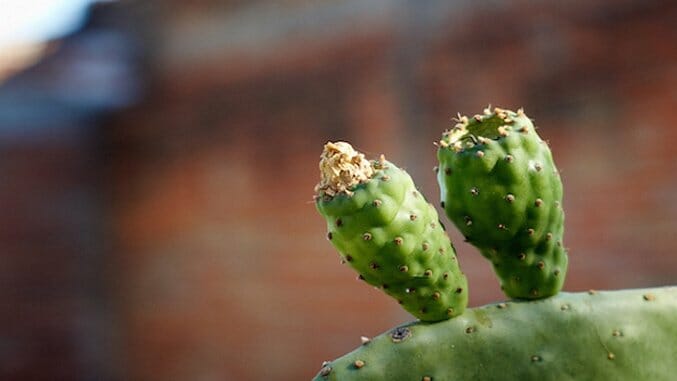
Xoconostle, admittedly, is one you may not have encountered before. It’s relatively rare in the United States—you’re not likely to encounter it in the average supermarket. It looks hard to pronounce and leaves a sour taste in the mouth of chefs and food lovers. But the latter is a good thing.
Type of Food: Fruit
Name: Oputina Lasiacantha Pfeiffer. The word xococ means “sour” in the native Mexican language Nahuatl. It’s sometimes also called tuna agria.
Origins: Xoconostle is the fruit from the Nopal cactus. According to chef Sergio Remolina, director of Latin American studies at the Culinary Institute in San Antonio, Texas, there’s research that shows xoconostle has been around for thousands of years. “It started to be domesticated the same time as corn,” he says. It’s a relative to both prickly pears and dragon fruits. Oh, and in case you’re wondering? It’s pronounced some variant of “cho-ko-nost-leh.”
Why/How Did We Start Eating it: “Cactus fruits have been part of native Mexican
diets for a long time,” likely thousands of years, says Remolina. It’s native to central Mexico.
How It’s Used: Typically, Remolina says, xoconostle is used in soups, stews and moles (particularly mole de olla, a rich beef stew), mostly in the central Mexican states such as Guanajuato, Querértaro, Hidalgo, Estado de Mexico and Tlaxcala. It’s also found in salsas and a soup called capon—a Mexican chicken soup. It sometimes shows up in a jam, too.
Ruben Ortega, executive pastry chef of Hugo’s and Caracol, both in in Houston, simmers the flesh with sugar, beet and fig leaves to be either blended with juice to make a sauce, or cut into candy form. He also says it’s possible to toast the seeds to make a powder that’s then mixed with sauces or salt to be rim a margarita or mezcal.
Chef-owner John Tesar of Knife at the Highland in Dallas suggests myriad uses for xoconostle: “Traditionally it’s used in salads and eaten raw. It’s almost like pickled watermelon rind. I’ve used it as a vegetable by cutting and boiling. Almost like a green bean. I’ve seen people in Mexico make omelets with it. I’ve seen people fry it like eggplant. We pickled and served it on top of pozole as a tart additive along with radishes and avocado. I’ve heard people using it for medicinal purposes. They suggest if you see prickly pear cactus in concentrate form you need to consult a doctor first.”
How it’s Purchased: ”[Xoconostle] is rare to find it fresh in the U.S. and only seems to be available during the holidays here, in November-December,” says Robert Schueller, produce guru for Melissa’s Produce. Remolina says you can often find it fresh, in the produce section at ethnic markets. Look for fruit that feels “heavy for its size, without wet spots or mushiness,” say Roberto Santibañez and J.J. Goode, authors of the cookbook Truly Mexican. Tesar says the most common find is “the purple one.”
You can also purchase xoconostle from the well-regarded bean purveyor, Rancho Gordo. It’s sold dried in plain, sweet or salty varieties. Dried xoconostle is often served alongside margaritas or shots of tequila. It’s also not uncommon to find this product in paste form, similar to Spanish membrillo.
Sensory Experience: Xoconostle has the texture of cactus pears, but it “tastes something like between tomatillo and lemons,” says Schueller. Remolina describes it thusly: “Acid taste. Grass smell. Very close to rhubarb.” Then again, chef Tesar says it “tastes similar to watermelon.”
You may be wondering, isn’t this just prickly pear? You’ve probably seen prickly pear as an ingredient listed in cocktails such as margaritas, but this isn’t the same. There are two sweet prickly pear cacti: tuna verde, which is green, and tuna roja, which is red, says Remolina.
Nutrition and other benefits: Xoconostle possesses vitamin C, calcium and fiber. Researchers at University of San Luis Potosi in Mexico have discovered some promising results in studies that involve this fruit’s potential to help regulate the blood sugar of people who are diabetic.
Carrie Havranek is a recovering music critic and part-time baker who writes about food, farmers markets, chefs and restaurants—and sometimes travel—from her home in Easton, Pennsylvania. You may have seen her work elsewhere in Edible Philly, the Kitchn, or Frommer’s.